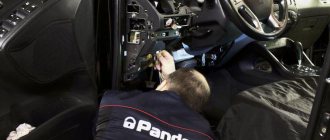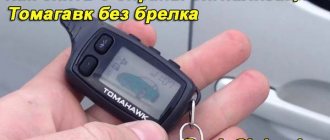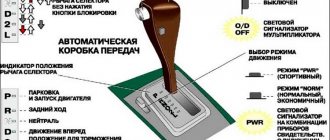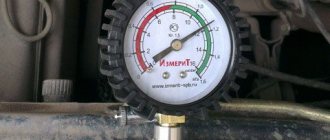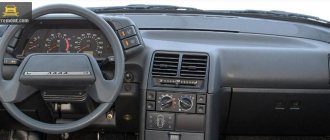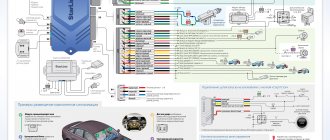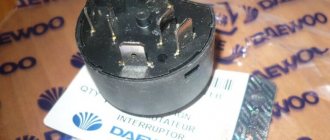Modern electronic car security systems are reliable and durable. However, the alarm may need to be removed. This can be done best by service station specialists. But this opportunity is not always available. Car owners are often confused by the high price of qualified service. This is due to the complexity and high labor intensity of such a procedure as replacing an alarm system.
If you wish, you can do this work yourself, following the instructions and guides on this topic.
Basic moments
Here's what you need to know about installation:
- The installation procedure as a whole is quite complicated. If the connection is incorrect, the alarm simply will not work. If you install GSM, your task becomes more complicated, since you will also have to program this system yourself. Therefore, before installation you need to weigh your strengths; If you feel that you cannot cope, you should seek help from an experienced specialist.
- Today on the market you can find systems such as Sheriff, Tomahawk and others. Anti-theft systems are very similar to each other, but are made from components of different quality, which can affect the performance properties of the device.
- There are several installation schemes for anti-theft systems. Therefore, when connecting, you should take into account the fact that in different systems, connectors of the same color can be used for completely different purposes.
- It is advisable not to use homemade anti-theft systems, since even experienced motorists make mistakes when making such devices that can lead to serious consequences (damage to automotive equipment, short circuit, and so on).
Video
This video contains instructions on how to completely remove the alarm from a car. The author of the video is “From Theft”.
Do you have any questions? Specialists and readers of the AUTODVIG website will help you ask a question
Was this article helpful?
Thank you for your opinion!
The article was useful. Please share the information with your friends.
Yes (100.00%)
No
X
Please write what is wrong and leave recommendations on the article
Cancel reply
Rate this article: ( 3 votes, average: 5.00 out of 5)
Discuss the article:
Self-installation of alarm systems
Let's look at the actual connection of the alarm using the example of the rather popular Starline A91 kit. We start by dismantling the elements, removing the instrument panel.
We work with things that are not electrical. We attach the antenna to the windshield. The “Valet” button is mounted in any place convenient for you, naturally, away from prying eyes. We attach the tilt sensor to the cross beam. You can immediately install the siren under the hood. Choose a location away from hot parts. The hole is directed downwards. This will protect the device from moisture and dirt. You can place the alarm control unit in any place convenient for you. The main selection criterion is invisibility to prying eyes and ease of connection. Don't choose the most popular options. This is where the burglar will go first.
Wiring connection
Let's move on to the wiring. We make the connection according to the diagram. You need to go to the turn signal, stop signal and clearance. We also run a wire under the hood to connect to the siren.
Let's take a closer look at working with the control unit. The colors look like this:
- Black for ground;
- Dark green for turn signals;
- For the siren you will need a gray positive wire. This is checked with a multimeter;
- We connect the hood end and the temperature sensor to the orange wire;
- Purple-orange leads to the handbrake.
We sorted out the control unit. What to do with the doors? We don't have a central lock, i.e. there is nothing to connect to. In this case, there are two options. We leave everything as is or install additional lock activators on the door.
Key fob programming
If the connection is successful, we proceed to programming the alarm key fobs. There is a detailed description of how this is done in the instructions. The main thing is to remember to switch to service mode. And keep the timing. If there is a break in working with key fobs for more than 5 seconds, the alarm will exit the setup mode.
To check the proper operation of the anti-theft system, return the battery to its original state. When switching, the alarm will work automatically and the siren will sound. Check the operation of the key fobs. If something does not work correctly, we check the wires and the correctness of their connections. Do not use an incorrectly connected alarm system. At best, it will not work properly, at worst, it will ruin the entire electrical system of the car.
Blocking via CAN bus
However, on modern cars there is an even more elegant way to block the engine from starting. In this case, there are no physically broken circuits, and there are no additional connections: it is enough for the alarm to have a connection with the car’s CAN bus.
The essence of such blocking is that when an alarm is triggered, the alarm transmits a blocking command via the bus and repeats it all the time until the alarm goes off. And until the thief turns off the central unit, attempts to start the engine will be useless. If we take into account that with proper installation of the central unit, half of the interior will need to be disassembled to remove it, then this method is clearly the leader in terms of efficiency. At the same time, there is no reason to fear reliability: the blocking relay can break, the contacts can oxidize, and this blocking is exclusively virtual and appears only when needed.
What determines the price of dismantling a car alarm at a service station?
The easiest way to remove the alarm is to contact a service station. It should not be surprising that the price for removing a car alarm is often no less than installing a new one. Typically, the cost of work is estimated at more than 2,000 rubles. It can be much more significant if:
- two-way alarm system;
- there is an automatic engine start system;
- original methods of engine blocking were used;
- special sensors are installed;
- there is an output for control via GSM or satellite channel;
- the alarm system is combined with an immobilizer;
- body tracking is organized not via a CAN bus, but by electrical wiring to the end switches of the doors, hood and trunk.
It may take more than one standard hour to dismantle all non-standard electrical wiring and security system devices. If the service station is guided by European repair standards (standard hour from 20 Euro, or 1,400 rubles), then 5 hours, according to calculation, for example, will cost about 7,000 rubles. In this case, it’s time to think about doing the work yourself.
How to turn off car alarms
The simplest, but “uncivilized” and emergency method of turning off the alarm is to cut the wire that goes to its sound signal with wire cutters. However, most often such a number will work with old alarm systems. Modern systems have multi-level protection. However, you can try this option. To do this, use the mentioned wire cutters or simply pull out the wires with your hands.
Another option is to locate the relay or fuse that supplies power and controls the alarm. As for the fuse, the story is similar. The old “alarm” may turn off, but the modern one is unlikely to. As for the relay, finding it is often not an easy task. It is necessary to go by the opposite method to find its location. The situation is complicated by this fact. that often in modern alarm systems the relays are contactless and can be placed in unexpected places. But if you are lucky enough to find it, disconnecting it from the circuit will not be difficult. This will de-energize the alarm. However, the described methods are no longer suitable for emergency shutdown, but for servicing alarms. Although it is better to entrust this process to professionals.
Next, let's move on to a description of how to disable individual alarms, which are popular in our country among car enthusiasts.
Wiring Diagram Details
There are always two relays inside the main unit. When installing a security alarm, the contacts of these relays are often included in wire breaks. After disconnecting the connector connected to the specified relays, the standard wiring may need to be restored. And recovery is fast.
Installing jumpers in the central locking connector
Install two jumpers by hand, as shown in the figure.
In general, it is better to start dismantling the alarm not by disconnecting the connectors, but by checking whether there is an autonomous siren in the engine compartment. Such equipment is first deactivated, and then disconnected from the car alarm. Manufacturers of security systems supply keys with the equipment.
Siren control key
With their inventions, the developers have gone so far as to install a GSM module in the main signaling unit that sends alarm messages. You cannot disconnect the antenna from it, especially if it is inside the module. But you can ask the owner to deactivate it.
After the steps listed here have been completed, it is advisable to turn off the power to the vehicle's electrical system. Why is the negative terminal removed from the battery? You can’t carry out this action just by hand - you need a key. The car alarm unit, in turn, is often equipped with a built-in battery. Be aware of this.
Step-by-step instruction
To completely remove the alarm from your car, you need to:
- Turn off the voltage in the car's electrical network. To do this, open the hood, loosen the negative terminal on the battery with a wrench and disconnect it.
- The next stage takes place inside the car. When performing this, you need to find the LED indicator located in the front of the car near the center console. A wire goes from the light bulb to the control unit. Find the module and disconnect the plug with contacts from it.
- Disconnect the standard wires from the on-board power supply. If the anti-theft system is equipped with an immobilizer, at this stage it must be disabled. Loosen the fasteners securing the device and remove the IMMO.
- The control module is connected to connectors for powering the lights of the turning lamps, clearance lights, door switches, trunk, as well as the power unit locking device. Each component is disconnected. If a complete replacement of the anti-theft system is required, then it is necessary to dismantle the electrical circuits connected to the components of the “signaling system”.
- Sensitivity, tilt, motion and other controllers are disconnected and dismantled if the car is equipped with them. Depending on the car and model of the alarm, as well as the installation method, the location of the devices may be different. Typically installers place these sensors under the parking brake control handle.
- If a motor blocking device is used, the contacts from the power unit must be removed carefully. The same applies to blockers of the starter device, fuel pump, etc.
- When all components are disabled, the Valet service button is removed. The siren installed under the hood of the car is dismantled. After removing all the clamps, the old wires coming from the passenger compartment to the engine compartment are removed.
- The battery is connected, the driver needs to try to start the engine. If the shutdown procedure is performed correctly, then there will be no problems with startup.
The From Theft channel demonstrated the procedure for dismantling an anti-theft installation using the example of a Toyota Rav4 car.
Disabling the alarm
There may be situations when it is necessary to turn off the alarm without using the key fob. For example, if it breaks down or the batteries run out. In this case, it is impossible to get into the car because the doors are locked and the system does not allow the engine to start.
To turn off the car alarm you need to perform a number of steps. First of all, you should turn off the speaker so that the signal does not attract the attention of others. If there is no key to the security system, it is enough to disconnect the corresponding contact.
Checking the control key fob
The key fob may freeze if the battery loses charge. In this case, failures may occur when synchronizing the engine start, and an emergency shutdown of the security system will be required. This involves unlocking the system and then starting the engine, and possibly dismantling the alarm system.
You can use a secret button, you just need to know the place where it is located. The instructions that come with the alarm may provide advice on how to turn it off in an emergency and how to remove the immobilizer. As a last resort, you can contact the service center.
Valet service button
In order to use the secret button, you need to do the following:
- turn on the ignition;
- the button must be pressed a certain number of times, usually it corresponds to a PIN code (usually it varies from 1 to 4);
- turn off the ignition.
After completing the steps, you need to check the fuse and power supply, and then start the engine again. If the alarm continues to sound, you need to remove the negative terminal of the battery and turn off the power supply to the car completely.
Loading …
Typical faults
Car alarm breakdowns are not always related to the operating system, which makes it possible to carry out repairs yourself. But in order not to drive the car to the nearest service station in a panic, it is necessary to determine the malfunction. To do this, you need to familiarize yourself with common car alarm breakdowns.
Car alarm malfunctions
Nutrition
If there are problems with power supply, the machine stops responding to signals from the control panel. Most often, the reason lies in a dead battery that simply needs to be changed. The low battery of the key fob is indicated by a gradually decreasing radius of its action.
Replacing the battery in the alarm key fob
Electric circuit
Exposure to high humidity combined with temperature changes can lead to oxidation of the wiring. As a result, the electrical circuit has no way of transmitting signals. Problems often arise after installing additional electrical appliances. Fuses can also cause wiring problems. For diagnostics, a special device is required - a tester or the help of a specialist.
Car alarm wiring
Battery
The sudden activation of the car alarm siren may indicate a low battery. The fact is that when the battery charge drops to 8 V or below, the anti-theft system is triggered, perceiving the drop in voltage as an attempt to steal a car. If the reason is the battery, then first you need to turn off the alarm, and then charge or replace the power source.
Checking the battery charge
Software malfunction
A common cause of inadequate alarm operation is a software violation. The system suddenly starts to “glitch” (blocks the engine, does not turn on the security mode, trips for no reason, etc.). In such cases, independent repair is impossible - you need to install new software or replace the security system.
Alarm software malfunction
Circuit breakers
It is recommended to check the fuses regularly, regardless of whether the car is working properly or not. These are small parts that tend to burn out. Therefore, if the alarm system begins to work incorrectly, it makes sense to check the functionality of the fuses. You also need to inspect the elements responsible for the emergency lights and the sound signal.
Fuses on car are blown
Remote control failure
As you know, the security system is controlled using a special remote control, which can also fail, as happens with various electronic products. Most often, the key fob breaks due to exposure to water, a fall, or a low battery. Mechanical damage not only reduces the efficiency, but also the comfort of using the device.
Car alarm remote control failure
Reasons for dismantling
Removing a car alarm may be necessary for several reasons:
- Complete failure of the signaling system.
- The system began to glitch: unstable operation in different modes.
- Buying a used car with an unknown car alarm for which no instructions could be found.
- I am not satisfied with the standard anti-theft system: for example, there is no auto start or other options.
- There was a desire to install a more advanced anti-theft kit.
- Replacing the alarm unit is more expensive than buying a new kit.
- The new owner fears that the secrets of the security system that belonged to the previous owner will be used by car thieves.
Types and configurations of car alarms
When installing an alarm system yourself, the degree of complexity of the process depends on the type of equipment chosen. And the type, in turn, is determined by what security and service functions the car owner would like to receive from the alarm system. By and large, modern car alarms (more precisely, security systems) can be divided into three large classes:
- Simple car alarms;
- Alarms with feedback;
- GSM alarms.
Simple car alarms (colloquially “openers”) have a minimum set of service functions:
- remote arming (disarming),
- remote unlocking (locking) of doors,
- “panic” mode (scaring away with sound and light signals or searching for a car in a large busy parking lot).
Several security functions are usually added to this set:
- in case of unauthorized access, engine start blocking,
- triggering of sound and light signals from penetration into the interior, engine compartment and trunk (unauthorized unlocking) and from mechanical impacts on the protected vehicle (impact, rocking).
A distinctive feature of this type of alarm is the outdated (and therefore easily identified by attackers) radio communication protocol (simply - a radio command transmitted from the key fob to the control unit). This is perhaps the main drawback of such a system.
In addition, commands are sent from the key fob, and what the car “responses” to them can only be understood when it is within sight and/or audibility. Therefore, such alarms are also called one-way, and their range of action is limited to several tens of meters. The main advantage of alarm systems for cars of this class is their low price.
Car alarms with feedback have an expanded range of service functions and a modern interactive radio communication protocol. In everyday language, this means that the owner of the car has the opportunity not only to send a control signal, but also to receive from the car a report on its execution, as well as information about the current state (whether there have been any hacking attempts) on the screen of the key fob pager. As for the dialogue protocol, it provides not just a command to the control unit, but the exchange of data with it, which is a very difficult task to intercept.
Finally, it should be noted that the service capabilities of this type of equipment have significantly expanded:
- remote engine start,
- turbo timer (engine idling to cool the turbocharger after parking and arming),
- window closer (hatch if equipped) – automatic raising of the windows if they were open,
- special interior lighting modes and much more.
The range of such alarms can reach several hundred meters, and the price is on average two to three times higher than that of openers.
GSM car alarms are a fundamentally new level of security systems. The main unit contains a GSM module (hence the name), a geopositioning module (GPS) and a controller (in fact, it is a computer for collecting, processing and issuing information).
The first module is essentially similar to a mobile phone - receiving and transmitting signals within the range of mobile communications. The second one uses a satellite to determine the geoposition of the car at the current moment. The controller processes information from sensors and calculates the parameters of control signals.
Monitoring the condition and controlling the vehicle can thus be carried out via SMS and voice messages, as well as through a web interface (on the Internet, or, as they say now, via telematics).
In addition to a qualitatively new expansion of functionality, this type of alarm has an unlimited range of action within the coverage area of the cellular network. Unfortunately, the price of such equipment is fundamentally higher than the cost of traditional car alarms.
Once the type of alarm has been selected and the required set of security and service functions has been determined, it is necessary to understand whether all these functions are provided by a specific model of the security system and whether all the necessary sensors and actuators are included in the delivery package.
For example, a car owner would like to install a tilt/roll sensor, and there is the possibility of connecting such a sensor, but the sensor itself is not included in the kit. Therefore, before purchasing an alarm, you must carefully study its technical characteristics.
What do you need to know before removing the alarm?
When removing an anti-theft system installed on a car, you must pay attention to the following principles and features:
- Disabling the “alarm” of a Starline, Alligator or other car model should be carried out by specialists or car owners who understand the principle of operation of the electrical network and the removal of anti-theft systems. If you incorrectly disconnect the main module or elements of the car alarm, this can result in a short circuit and other malfunctions.
- During the shutdown process, the alarm may lock the motor, resulting in the engine being unable to operate. If you disconnect the wires while the power is on, some Starline and Alligator models begin to sound a siren, which cannot be turned off with the key fob. The anti-theft system may include a special key that can be used to turn off the sound signals. You can also turn off the siren yourself using a personal password entered using the Valet service key.
Safety precautions during dismantling
To remove the old alarm from your car yourself, you need to consider the following safety rules:
- Before performing the task, you must make sure that there is no power to the network. If the alarm is dismantled while there is voltage, the car owner may receive an electric shock, and in such a situation there is a possibility of electronic failure.
- After the car owner completes dismantling, it is recommended to check the operation of the alarm elements to detect the causes of inoperability or failures. Diagnostics should be carried out in special clothing and using rubber gloves.
Volkswagen central locking, pneumatic
In fact, we have not considered another type of central locking system - pneumatic or vacuum locks. They are controlled using one cable, not two. The control wire can be found in the trunk (near the compressor), under the rear seat, and so on. When opening, there will be a “plus” on the wire; when closing, it is connected to ground. The found control cord will have to be cut. Both parts of the cord are connected to the signaling (details are discussed below).
Here is an example of connecting an alarm:
Pneumatic central locking control, diagram
The same in the form of letters:
- Unlocking NR – to “+12 V”;
- Closing HP - to ground;
- Unlocking NC - to that part of the cord that goes to the central lock control unit;
- Closing NC - to the “common” lobe of the unlocking relay;
- The “common” petal of the closing relay is to the second half of the cord (to the actuators).
We hope no questions arise here. But still, just in case, we will open the comments.
In conclusion, we note and emphasize once again that any installation work is carried out with the negative terminal disconnected.
We are talking about the battery terminal that powers the electrical network. When laying a new cable, use heat-resistant insulating tubes or electrical tape. All equipment installed in the car is located in an aggressive environment. This must be remembered.
Replacement of security and fire alarm equipment
May be needed in the following cases:
1. Introduction of new data transmission technologies. Older models of security alarm systems were connected to regular telephone lines and required replacement only when their useful life had expired. However, with the widespread introduction of optical technologies, the mass refusal of consumers from landline city telephones, and the development of the Internet, there is increasingly a need to replace security alarm devices with more modern ones. Often, an outdated security and fire alarm system simply stops working when the city telephone network switches to new technologies.
2. The need to expand the functionality of the security system. For example, digital components for video surveillance provide the user with greater capabilities compared to analog ones. This includes a quick search for information based on specified characteristics, frame scaling, more convenient integration of video surveillance with other systems, and broadcasting video over the Internet in real time.
3. Physical wear and tear of individual system elements. Often, in this case, compatible components of the latest type are installed, which are less likely to break and have better characteristics.
4. Changes in the configuration, area, and operating conditions of protected premises. If it is necessary to expand the surveillance and fire extinguishing area, new equipment may be required, which will entail modernization of the entire system. At this stage it is convenient to update its individual elements.
It is not necessary to purchase all the equipment from scratch; this can be quite costly. By turning to qualified specialists for diagnostics, you can draw up an optimal strategy for upgrading your security and fire system and get the best result in terms of price-quality ratio. In addition, if we are talking about sensitive enterprises, organizations working around the clock, about objects with a large amount of material assets, where long-term shutdown of such systems is absolutely unacceptable, the qualifications of workers are extremely important.
The Integrated Security Alliance is a high-quality design, installation, diagnostics and replacement of security alarms at facilities of any complexity in the shortest possible time. The company ensures timely replacement of devices and other system elements on the basis of maintenance contracts, preventing equipment failure in situations associated with additional risks for the client.
Features of services
If you have problems with the alarm, hurry up and contact our service center. We provide services for disabling and repairing car alarms in the South-Western Administrative District, servicing various systems installed on cars of domestic and foreign production. If necessary, we will arrange for an auto electrician to travel to any location in Moscow and the region. It will restore settings and unlock the security device even on the side of the road where your car is stopped.
We offer to repair more serious damage in our service center. The price for car alarm repair depends on the complexity of the equipment and the cause of the malfunction. And in this matter, money is not the main thing. By contacting us, you can avoid many troubles.
Our masters:
- carry out diagnostics;
- determine the localization of the problem;
- will dismantle the car alarm (if necessary);
- repair or replace failed components;
- connect the equipment;
- carry out the setup;
- They will perform a performance check.
If the breakdown cannot be repaired, we will replace the equipment with further maintenance. Car alarm repair on-site in Moscow (South-Western Administrative District) - prompt solution to problems at a price convenient for you!
What causes problems with the signal system?
Incorrect operation of the security system can be associated with various problems. Most often, failures occur precisely because of poor-quality equipment. Extremely low or high air temperatures cause problems. Incorrect operation is also associated with malfunctions of the internal components of the device.
A problem may be indicated by overly sensitive operation or problems occurring when turning the equipment on or off. Motorists often encounter false alarms. All of these problems indicate that your vehicle's safety equipment is in urgent need of repair.
Problems with a faulty key fob can be caused by the following reasons:
- Too much radio interference that interferes with the normal operation of the alarm panel;
- Problems with the car battery;
- Low battery.
If the breakdown is due to a dead battery in the key fob, try taking it out, shaking it slightly and putting it back in place. Manipulations of this kind will help to revive the device for a few minutes. Don't forget to replace the dead battery.
Very often, problems with the signaling arise due to a dead battery in the key fob.
Dismantling Guide
It is necessary to remove the old alarm from the car when installing a new one. Removing the main car alarm unit may be necessary when updating the software or updating its settings so that it meets the security requirements of modern security systems. Sometimes it is necessary to dismantle parts of the anti-theft system for repair and replacement (video author - SpetsAvtoSystems).
Modern security systems reliably protect cars from theft and entry; they have an increased degree of protection against code reading and interception.
Tools and materials
It is difficult to dismantle the alarm system, since its elements are hidden as far as possible so that they are invisible. Many owners do not know where the car alarm is installed, so it is better to entrust the dismantling to specialists.
If you decide to dismantle the anti-theft system yourself, you will need a small set of tools:
- screwdriver;
- multimeter;
- side cutters;
- insulating tape.
In addition to tools, dismantling work will require patience.
Disabling the alarm without a key fob
Stages
Dismantling the anti-theft system consists of the following steps:
- First of all, you should turn off the power to the car by removing the negative terminal from the car battery.
- First you need to find the LED on the dashboard. A wire goes from it to the control unit. It is necessary to disconnect the connector with wires.
- Now you can disconnect the standard wiring from the electrical power system, and you also need to remove the immobilizer.
- The electrical circuit of the anti-theft system is connected to the turn signals, dimensions, trunk, doors, . When removing each element, it must be correctly disconnected from the car alarm.
- Next, you need to remove the shock and internal volume sensors, which are usually located under the handbrake lever.
- You should be very careful when disconnecting the contacts on the motor. Modern security alarms are equipped with locking mechanisms for the starter, fuel pump and ignition system.
- After disconnecting the contacts, you need to find and dismantle the Valet service button, as well as the siren, which is located in the engine compartment. After removing the fasteners, you need to remove the wiring coming from the interior.
- Now you can try to start the engine. If the alarm was correctly removed, the engine will start without problems.
Removing an old car alarm
If the anti-theft system is dismantled on your own, then the following consequences are possible if dismantling is incorrect:
- the integrity of the electrical wiring is compromised;
- malfunctions of electrical equipment;
- the decorative trim of the interior is damaged;
- engine starting is blocked for no reason;
- the removed element is damaged and can be reused;
- damage, the elimination of which can be costly.
Installing a new alarm
After dismantling the old anti-theft system, you can begin installing a new security system. To do this, you should follow the following procedure:
- Disconnect the on-board network.
- Carefully study the composition and purpose of the system parts, as well as the instructions for installing the equipment.
- Mark the installation locations of the blocks and devices of the kit.
- Remove that part of the interior lining where hidden installation of devices and cables is planned.
- Prepare fastening and insulating materials: clamps, staples, screws, nuts, electrical tape, casings, heat-shrinkable tubing.
- Stock up on a set of necessary tools.
- Mount the main blocks, sensors and limit switches.
- Install the immobilizer assembly.
- According to the diagram, connect the system elements with harnesses and cables.
- Adjust the sensors and limit switches to the working position.
- Connect the battery.
- Try to start the engine and check the functionality of the installed equipment in all modes.
Common node faults
Often the central locking of the VAZ-2114 is controlled incorrectly due to the fact that the contact pairs are closed with a delay. A common reason for this is a violation of the adjustment of the thrust located between the gearmotor and the lock button, or its jamming. Simply put, when the button is pressed, the position of the rod does not allow the contact pairs of the drive to be completely closed.
The door on the driver's side may be locked, while the others will remain open due to the fact that the contacts of the control unit are not fully closed. This malfunction is purely mechanical in nature, and to eliminate it, it is enough to adjust the rod or the free play of the button in case it gets stuck.
In addition, such a problem can be caused by a malfunction of the VAZ-2114 central locking relay. In this case, you will have to replace the failed element.
In the case when the VAZ-2114 central locking completely stops responding to commands given by the driver, it is worth moving on to checking the electrical part of this unit. It is possible that this behavior of the system is caused by a blown fuse. Note that it can fail not only in the event of a short circuit, but also from constant overloads caused by the heavy movement of the core, or a violation of the adjustment of the rods.
Quite often, the reason why the VAZ-2114 central lock does not work is a violation of the integrity of the electrical wiring supplying power to it. The wires in the driver's door of a vehicle almost always break because it opens and closes more often than others. You can determine the damaged section of the wire using a multimeter. Less often than not, the control unit fails. In this case, the entire system either completely stops working or performs its functions incorrectly.
To prevent module malfunctions, it is necessary to pay attention to the condition of the activator, since its contacts can oxidize or burn, causing malfunctions. Periodic cleaning will significantly extend the life of the module.
Next we will look at how to correctly connect the signaling system on cars of the VAZ 2114 family. The following will be implemented: connection to the central locking, auto start, reading the status of door limit switches. To control the central locking, the VAZ plant produced BUBD modules. If such a module is missing, the task will be simplified - you will not connect the central locking system. The same applies to the case when the driver's door only has a switch, but not an actuator. All tables given here are suitable for the Starline A91 Dialog alarm system, and to set up another system, use the instructions for it.
Possible consequences and their solutions
Removing elements of the anti-theft system from the standard vehicle system, as well as dismantling the satellite alarm system, is a complex procedure. It is not always possible to avoid mistakes and shortcomings.
As a result of poorly done work, malfunctions in the machine may occur:
- the engine stops starting, stalls or runs intermittently;
- fuel consumption increases;
- The lighting equipment does not work.
Most often, the cause of failures is poor-quality connection of electrical circuit elements.
It happens that a section of wiring is missed, in the gap of which there was a removed element. Improper connection of conductors can cause a short circuit, as well as failure of the main equipment.
Often, after dismantling, the battery no longer holds a charge and quickly loses capacity.
If the listed malfunctions are detected, all electrical connections should be carefully checked. You can check the wiring for breaks or short to ground with a multimeter.
During careless dismantling, cables and conductive harnesses are damaged. If it is not possible to accurately determine the location of the break and carry out repairs, the harness must be changed completely.
The head unit may be damaged. It needs to be diagnosed. The malfunction can sometimes be eliminated by soldering the microcircuit tracks. In some cases, flashing the module helps.
How to choose the right alarm
Of course, there are now millions of such options. And they will cost from five to seven thousand to infinity. But what is their price formed from? It all depends directly on the filling of the anti-theft agent. The more additional functions, the higher the price.
Standard security system
If you don’t want to spend a lot of money, choose a universal option, which should include:
- Siren;
- Feedback to keychain;
- And at least one additional option, for example, car tilt control.
A loud siren will awaken and attract the attention of the entire neighborhood. This option is interesting when the car is parked under the windows
No burglar will like this, and, most likely, if he cannot quickly (2-3 seconds) neutralize it, he will give up his bad idea. If we talk about feedback, then such a thing will attract your attention.
Wherever you are (in a store, at home, at a party, at work) you will hear a signal and go to check the condition of your car. Well, the tilt control sensor simply won’t let you be left without wheels. When you try to remove them, you will hear a siren and receive a signal on the key fob. Thus, we buy a standard universal alarm system from a trusted manufacturer, which should include:
- Control block;
- Keyrings;
- A bunch of wires;
- Siren;
- Small antenna for communication with the key fob;
- Instructions;
- And all kinds of other fillings, depending only on the number of additional options.
Do not under any circumstances throw away the instructions after installation. You may still need it to program new key fobs if the old ones fail.
Installation tools
If you decide to do everything yourself, figure out in advance what you will need, why, why and how to use it. In principle, the set of tools is quite standard, but it’s better to get acquainted with the multimeter in advance. This device is necessary to determine the necessary wires when connecting electrical equipment. There is no way to do without him. For our task, it is better to use the electronic version of the device. What else you need to collect:
- Protective corrugated tubes;
- Hammer;
- Screwdriver;
- Screwdriver;
- Black resistant electrical tape;
- Double sided tape;
- Perhaps a set of additional wires.
An extra set of electrics can be useful if what is in the box is not enough, especially since you need to hide the central unit as far and deep as possible. The antenna is attached to double-sided tape, and insulating tape is needed to rewind the wire connections. All, absolutely all joints are wrapped with this tape. The color does not have to be black. It matches the original wiring.
How to completely remove the alarm from a car with your own hands
No special theoretical preparation is required here. Main:
- be extremely careful;
- follow the general rule “check twice, cut once”;
- perform work efficiently, isolate conscientiously;
- carefully carry out dismantling and installation work in the interior, especially with plastic elements;
- comply with electrical and fire safety rules.
In many cases, careful dismantling of a car alarm on your own is more reliable than the work of an unqualified garage technician. He has one goal: to get money as quickly as possible. In principle, a car alarm can be removed using side cutters, a pair of jumpers and electrical tape in half an hour. In this case, unnecessary wires and other “snot” will remain hanging.
The danger of incorrectly dismantling a car alarm
If you quickly remove the alarm from a car, the following problems may occur:
- fire of electrical wiring
due to short circuits of the remaining abnormal wiring. They can cause the car to catch fire; - engine start failure
. This will happen one hundred percent if the non-standard alarm system had an autostart system. If you do not restore the locks of the old security system, it will also be impossible to start the engine. Often, alarm installers use original "proprietary" locking methods that are difficult to detect; - malfunction of general electrical equipment, errors
in vehicle systems, if the wiring is not completely restored; - failure of individual vehicle systems
, for example, central locking.
Required tools and materials
Before you completely remove the alarm from the car, you need to stock up on a set of tools, equipment and materials to complete the work. It should be taken into account that during the work the car will be inoperable and it will not be possible to use it to pick up the necessary equipment. This work should not be performed in a country house or other place remote from the house, parking lot or garage. You may need outside help or specialist advice.
Minimum set:
- electrical tape, heat shrinkage (special cambric that shrinks in size when heated);
- side cutters, pliers;
- a set of metalwork tools;
- Screwdriver Set;
- sharp assembly knife;
- light source stationary (safer LED) and mobile;
- documentation for the installed car alarm or the ability to have mobile Internet access to download connection diagrams;
- soldering kit: flux, solder, soldering iron.
If you do not have soldering skills, you can, as a last resort, limit yourself to connecting the conductors using the twisting method plus heat-shrink insulation.
Sequence of work
1. Remove battery terminals
, having first checked that “The ignition is turned off”.
2. Determine the installation locations of all car alarm components
. The central unit is usually located under the dashboard near the left pillar of the car. If the fuse box is located in this place, then there is a high probability that the block is hidden under the upholstery. Non-standard wires must lead there. After removing the central unit, you should read the car alarm model, download and familiarize yourself with its connection diagram. Using the diagram, you can determine which connectors and what colors of conductors other car alarm devices are connected to.
They go sequentially along the wires to the locations:
- secret button;
- indicator LED;
- additional sensors;
- relay;
- connection points;
- auto start transponder (if equipped);
- fuses;
- antenna module;
- sirens and other devices.
3. After determining all installation locations, the alarm units are dismantled
. If they are installed on plastic clamps, they are removed using side cutters.
When installing on self-tapping screws, use screwdrivers. This may require dismantling some vehicle components.
4. Next, proceed to sequentially disconnect the electrical connections of the devices from the central alarm unit
. The easiest way is to remove the LED, hidden button, siren wiring, additional sensors, antenna module, transponder, transponder loop.
The fuses should be turned off, the power connection wires should be disconnected, and the areas should be insulated.
5. Disabling connection points for blocking systems, relays
. This is the most critical stage. To do this, you need to have a car alarm circuit. It’s easier if the car alarm has a CAN connection to car systems, then just disconnect this connector without further action: the CAN bus will be useful for installing a new alarm system. In the case when blocking is carried out using relays or devices located in the central unit, it is necessary to restore the blocking circuits.
For the relay, you should find the contact diagram on its body. Next in the diagram you should look for interrupt contacts.
The conductors coming to the interrupt contacts must be traced to their connection points in the car. The connection points should be disconnected from the relay and the contacts restored (cleaned, twisted, soldered, insulated). All locks are restored in a similar way. Typically, the alarm system contains two to four interlocks. Some interlocks can be organized using relays included in the central unit. They can only be tracked by its connection diagram.
6. If the car alarm does not have a CAN bus, the doors are monitored using limit switches. All non-standard wiring should
, which runs from the central block to the doors, trunk and hood. This kind of work takes a lot of time, but is necessary.
The result of the work is the complete removal of abnormal electrical wiring, restoration and isolation of all car alarm connection points.
7. At the final stage, a final check of the quality of work
. Next, connect the battery terminals. In this case, it is necessary to monitor the absence of foreign odors in the cabin and the operation of fuses. Perform a test run of the engine. If it was successful, a re-check for the absence of foreign odors is carried out and a test drive is carried out with the turn signals and side lights turned on. Also check the operation of the central locking.
The alarm dismantling activity is considered completed if, upon completion, all vehicle systems are operating normally.
Read how to remove an air lock from the cooling system and why it is important to resolve this issue immediately.
How it works and how to choose the right 12/220 Volt car inverter.
What is a car sharing car https://voditeliauto.ru/poleznaya-informaciya/online/carsharing.html and how to use it.
Video - dismantling the Pandora dxl 3930 alarm system from a JAGUAR XF 2015 car:
May be of interest:
Scanner for self-diagnosis of a carAdd your advertisement How to quickly get rid of scratches on a car bodyAdd your advertisement Selection of useful accessories for car ownersAdd your advertisement Compare auto products by price and quality >>>Add your advertisement
What you need to know before installing an alarm
Before installing an alarm system on your car, you should not rely on videos or advice on blogs. The good wishes of car owners are not general instructions, and when connecting the “alarm” on different brands of cars, not only the type of car is taken into account, but also the year of its manufacture, type and much more. The fact is that the connection diagram will differ in different situations. This is done for a reason. If all systems work according to the same principle, then it will be much easier for hackers to bypass them. Therefore, it is best to familiarize yourself with the standard wiring of your car and the instructions for a specific alarm.
This is interesting: Types of heated covers for car seats
Important! There are many wiring diagrams for security systems, where the colors of the wires may differ from generally accepted standards. Some manufacturers create new wiring diagrams that even experienced installers cannot figure out.
Here is an example of a typical connection diagram for a modern alarm system from StarLine, model A91.
It can be seen from the diagram that only those wires that come with it are marked with colors. The wires to which the connection is made, and these are the wires of the car’s electrical network, are indicated by black lines. Therefore, when carrying out work, you will have to combine two existing circuits (alarm circuit and car electrical circuit).
Be sure to use electronic meters to “ring” so as not to confuse anything. It is not recommended to use the usual “paw”.
The main alarm connection points are as follows:
- “+” - positive polarity (location point in the engine ignition switch);
- starter – negative polarity (placement point in the ignition switch);
- ACC – positive (point in the ignition switch);
- ignition – positive (can also be located in the ignition switch);
- central locking – negative;
- doors – positive;
- dimensions – positive (location point in the dimensions switch);
- brake – positive (location in the “frog”).
It is also better to immediately decide where you will place all the sensors and the car alarm unit itself. And also prepare all the necessary tools.
Central lock designs
Advanced car central locking configurations include:
- Control block;
- electrical supply cables;
- input sensors;
- remote controls;
- actuators (actuators);
- additional devices (window closers, electric sunroof, electric trunk locks, fuel hatch lock).
In basic configurations, the central locking control unit, after turning the key, removes the locks from the locks of all doors, activating the actuators.
The same functions are performed by the car alarm control unit, which is devoid of actuators, so harmonizing two systems built on different principles becomes the main task of the installer.
